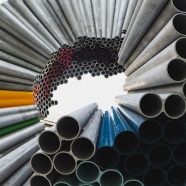
How is plastic tubing extruded? This question is best answered by first understanding what plastic tubing is. Plastic tubes are hollow, cylindrical shapes made from thermoplastic or thermosetting plastic. It can be either rigid or flexible and is used in many different applications.
To create plastic tubes, manufacturers begin with a large cylinder of plastic called an extruder which heats the plastic until it is soft enough to be forced through a small hole called a die. As the plastic emerges from the die, it is cooled and takes on the shape of the die. The tubing is then cut to the desired length and cooled completely.
What Are Its Applications?
Plastic tubing extruded can be made from many different types of plastic, including PVC, ABS, and polyethylene, for various applications in numerous industries, including aerospace, construction, electronics, and more.
The type of plastic used will depend on the intended use of the tubing. For example, PVC tubing is often used in plumbing applications because it is resistant to corrosion. Polyethylene tubing is often used in food and beverage applications because it is FDA approved for contact with food.
The plastic extrusion process can be customized to produce plastic tubes with different features. For example, manufacturers can add colorants to the plastic before extrusion to produce colored tubing.
They can also add UV inhibitors to the plastic to prevent the tubing from yellowing over time. Tubing can also be made with different wall thicknesses to meet the needs of various applications.
What Are The Benefits Of It?
Plastic tubing extruded can be formed into various shapes and sizes to meet the needs of different applications. For example, small-diameter tubing can be used in medical applications, while larger-diameter tubing can be used in construction applications.
However, the benefits don’t end there. Plastic tubing extrusion is also:
Customizable
The plastic extrusion process can be customized to produce plastic tubing with different features. For example, manufacturers can add colorants to the plastic before extrusion to produce colored tubing.
They can also add UV inhibitors to the plastic to prevent the tubing from yellowing over time. Tubing can also be produced with different wall thicknesses to meet the needs of various applications.
Versatile
Plastic tubing extruded is carried out in many different types of plastic, including PVC, ABS, and polyethylene. The type of plastic used will depend on the intended use of the tubing.
For example, PVC tubing is often used in plumbing applications because it is resistant to corrosion. Polyethylene tubing is often used in food and beverage applications because it is FDA approved for contact with food.
Durable
A plastic tube is a durable product that withstands a lot of wear and tear, making it suitable for applications where it’s exposed to high temperatures or chemicals.
Resistant To Corrosion
Some plastic tubes, such as PVC tubing, are resistant to corrosion. This makes them ideal for applications where they will be exposed to chemicals or other corrosive materials.
Easy To Install
Plastic tubes can often be glued or welded into place, making them a popular choice for applications needing a permanent connection.
How Keller Plastics Is The Best Plastic Extruded Tubing Manufacturers
Keller Plastics manufactures custom plastic tubes for many industries. We use the plastic extrusion process to produce various shapes and sizes of plastic tubes. The extrusion process can be customized to produce tubing with different features, such as wall thicknesses or added UV inhibitors.
We use high-quality materials to produce our tubing and offer various finishes to meet our customers’ needs. Contact us today to learn more about our plastic tubing manufacturing capabilities. Get in touch with us today to request a quote!




